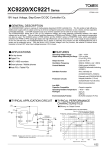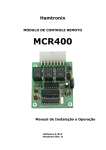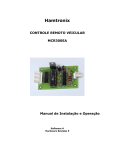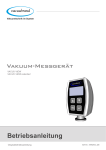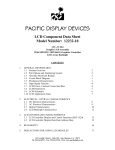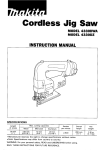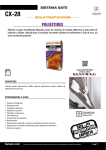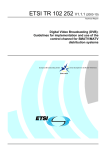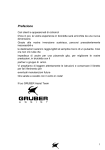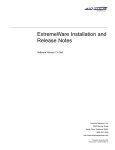Download Ricoh RH5RH13B User's Manual
Transcript
PWM STEP-UP DC/DC CONVERTER RH5RH ×× 1A/ ××2B/ ××3B SERIES APPLICATION MANUAL ELECTRONIC DEVICES DIVISION NO.EA-023-9803 NOTICE 1. The products and the product specifications described in this application manual are subject to change or discontinuation of production without notice for reasons such as improvement. Therefore, before deciding to use the products, please refer to Ricoh sales representatives for the latest information thereon. 2. This application manual may not be copied or otherwise reproduced in whole or in part without prior written consent of Ricoh. 3. Please be sure to take any necessary formalities under relevant laws or regulations before exporting or otherwise taking out of your country the products or the technical information described herein. 4. The technical information described in this application manual shows typical characteristics of and example application circuits for the products. The release of such information is not to be construed as a warranty of or a grant of license under Ricoh's or any third party's intellectual property rights or any other rights. 5. The products listed in this document are intended and designed for use as general electronic components in standard applications (office equipment, computer equipment, measuring instruments, consumer electronic products, amusement equipment etc.). Those customers intending to use a product in an application requiring extreme quality and reliability, for example, in a highly specific application where the failure or misoperation of the product could result in human injury or death (aircraft, spacevehicle, nuclear reactor control system, traffic control system, automotive and transportation equipment, combustion equipment, safety devices, life support system etc.) should first contact us. 6. We are making our continuous effort to improve the quality and reliability of our products, but semiconductor products are likely to fail with certain probability. In order prevent any injury to persons or damages to property resulting from such failure, customers should be careful enough to incorporate safety measures in their design, such as redundancy feature, fire-containment feature and fail-safe feature. We do not assume any liability or responsibility for any loss or damage arising from misuse or inappropriate use of the products. 7. Anti-radiation design is not implemented in the products described in this application manual. 8. Please contact Ricoh sales representatives should you have any questions or comments concerning the products or the technical information. June 1995 RH5RH SERIES APPLICATION MANUAL CONTENTS OUTLINE ......................................................................................................1 FEATURES....................................................................................................1 APPLICATIONS .............................................................................................1 BLOCK DIAGRAM .........................................................................................2 SELECTION GUIDE .......................................................................................2 PIN CONFIGURATION ...................................................................................3 PIN DESCRIPTION ........................................................................................3 ABSOLUTE MAXIMUM RATINGS ...................................................................4 ELECTRICAL CHARACTERITICS ...................................................................5 OPERATION OF STEP-UP DC/DC CONVERTER ...........................................10 TYPICAL CHARACTERISTICS......................................................................13 1) Output Voltage vs. Output Current .......................................................................13 2) Efficiency vs. Output Current .............................................................................14 3) Supply Current (No Load) vs. Input Voltage ..............................................................15 4) Output Current vs. Ripple Voltage ........................................................................15 5) Start-up/Hold-on Voltage vs. Output Current (Topt=25˚C) ...............................................16 6) Output Voltage vs. Temperature .........................................................................17 7) Start-up Voltage vs. Temperature ........................................................................18 8) Hold-on Voltage vs. Temperature ........................................................................18 9) Supply Current 1 vs. Temperature .......................................................................18 10) Supply Current 2 vs. Temperature .......................................................................18 11) Lx Switching Current vs. Temperature ...................................................................18 12) Lx Leakage Current vs. Temperature ....................................................................18 13) Oscillator Frequency vs. Temperature....................................................................19 14) Oscillator Duty Cycle vs. Temperature ...................................................................19 15) Vlx Voltage Limit vs. Temperature ........................................................................20 16) EXT “H” Output Current vs. Temperature ................................................................20 17) EXT “L” Output Current vs. Temperature .................................................................20 18) Load Transient Response ................................................................................21 19) Distribution of Output Voltage ............................................................................22 20) Distribution of Oscillator Frequency ......................................................................22 TYPICAL APPLICATIONS ............................................................................23 • RH5RH ×× 1A .................................................................................................23 • RH5RH ×× 2B..................................................................................................23 • RH5RH ×× 3B..................................................................................................24 • CE pin Drive Circuit ............................................................................................22 APPLICATION CIRCUITS .............................................................................26 • 12V Step-up Circuit ............................................................................................26 • Step-down Circuit ..............................................................................................26 • Step-up/Step-down Circuit with Flyback .......................................................................27 PACKAGE DIMENSIONS ..............................................................................28 TAPING SPECIFICATIONS ...........................................................................28 PWM STEP-UP DC/DC CONVERTER RH5RH ×× 1A/ ×× 2B/ ×× 3B SERIES OUTLINE The RH5RH ×× 1A/ ×× 2B/ ×× 3B Series are PWM Step-up DC/DC converter ICs by CMOS process. The RH5RH ×× 1A IC consists of an oscillator, a PWM control circuit, a driver transistor (Lx switch), a reference voltage unit, an error amplifier, a phase compensation circuit, resistors for voltage detection, a soft-start circuit, and an Lx switch protection circuit. A low ripple, high efficiency step-up DC/DC converter can be constructed of this RH5RH ×× 1A IC with only three external components, that is, an inductor, a diode and a capacitor. These RH5RH×× 1A/ ×× 2B/×× 3B ICs can achieve ultra-low supply current (no load) –TYP. 15µA –by a newly developed PWM control circuit, equivalent to the low supply current of a VFM (chopper) Step-up DC/DC converter. Furthermore, these ICs can hold down the supply current to TYP. 2µA by stopping the operation of the oscillator when the input voltage > (the output voltage set value + the dropout voltage by the diode and the inductor). These RH5RH×× 1A/×× 2B/×× 3B Series ICs are recommendable to the user who desires a low ripple PWM DC/DC converter, but cannot adopt a conventional PWM DC/DC converter because of its too large supply current. The RH5RH×× 2B/×× 3B Series ICs use the same chip as that employed in the RH5RH×× 1A IC and are provided with a drive pin (EXT) for an external transistor. Because of the use of the drive pin (EXT), an external transistor with a low saturation voltage can be used so that a large current can be caused to flow through the inductor and accordingly a large output current can be obtained. Therefore, these RH5RH×× 2B/×× 3B Series ICs are recommendable to the user who need a current as large as several tens mA to several hundreds mA. The RH5RH×× 3B IC also includes an internal chip enable circuit so that it is possible to set the standby supply current at MAX. 0.5µA. These RH5RH×× 1A/×× 2B/×× 3B ICs are suitable for use with battery-powered instruments with low noise and low supply current. FEATURES • Small Number of External Components ..........Only an inductor, a diode and a capacitor (RH5RH ×× 1A) • Low Supply Current ...........................................TYP. 15µA (RH5RH301A) • Low Ripple and Low Noise • Low Start-up Voltage (when the output current is 1mA) ..................MAX. 0.9V • High Output Voltage Accuracy..........................±2.5% • High Efficiency ...................................................TYP. 85% • Low Temperature-Drift Coefficient of Output Voltage ......................TYP. ±50 ppm/˚C • Soft-Start .............................................................MIN. 500µs • Small Packages ...................................................SOT-89 (RH5RH ×× 1A, RH5RH ×× 2B), SOT-89-5 (RH5RH ×× 3B) APPLICATIONS • Power source for battery-powered equipment. • Power source for cameras, camcorders, VCRs, PDAs, electronic data banks,and hand-held communication equipment. • Power source for instruments which require low noise and low supply current, such as hand-held audio equip- ment. • Power source for appliances which require higher cell voltage than that of batteries used in the appliances. 1 RH5RH BLOCK DIAGRAM VLX limiter Lx Slow start Vref OUT Buffer Vss Phase Comp. LxSW PWM control – + EXT OSC Error Amp. Chip Enable CE Error Amp. (Error Amplifier) has a DC gain of 80dB, and Phase Comp. (Phase Compensation Circuit) provides the frequency characteristics including the 1st pole (fp=0.25Hz) and the zero point (fz=2.5kHz). Furthermore, another zero point (fz=1.0kHz) is also obtained by the resistors and a capacitor connected to the OUT pin. (Note) Lx Pin ............only for RH5RH ×× 1A and RH5RH ×× 3B EXT Pin .........only for RH5RH ×× 2B and RH5RH ×× 3B CE Pin ...........only for RH5RH ×× 3B SELECTION GUIDE In RH5RH Series, the output voltage, the driver, and the taping type for the ICs can be selected at the user's request. The selection can be made by designating the part number as shown below : } } } RH5RH ×××× – ×× ← Part Number ↑ ↑ ↑ a b c Code Description a Setting Output Voltage (VOUT): Stepwise setting with a step of 0.1V in the range of 2.7V to 7.5V is possible. b Designation of Driver: 1A: Internal Lx Tr. Driver (Oscillator Frequency 50kHz) 2B: External Tr. Driver (Oscillator Frequency 100kHz) 3B: Internal Tr./External Tr. (selectively available) (Oscillator Frequency 100kHz, with chip enable function) c Designation of Taping Type : Ex. SOT-89 : T1, T2 SOT-89-5 : T1, T2 (refer to Taping Specifications) “T1” is prescribed as a standard. For example, the product with Output Voltage 5.0V, the External Driver (the Oscillator Frequency 100kHz) and Taping Type T1, is designated by Part Number RH5RH502B-T1. 2 RH5RH PIN CONFIGURATION • SOT-89 • SOT-89-5 5 (mark side) 1 2 4 (mark side) 3 1 2 3 PIN DESCRIPTION Pin No. Symbol Description ×× 1B ×× 2B ×× 3B 1 1 5 VSS Ground Pin 2 2 2 OUT Step-up Output Pin, Power Supply (for device itself) 3 — 4 Lx — 3 3 EXT — — 1 CE Switching Pin (Nch Open Drain) External Tr. Drive Pin (CMOS Output) Chip Enable Pin (Active Low) 3 RH5RH ABSOLUTE MAXIMUM RATINGS Symbol Rating Unit Output Pin Voltage +12 V VLX Lx Pin Voltage +12 V Note1 VEXT EXT Pin Voltage – 0.3 to VOUT+0.3 V Note2 VCE CE Pin Voltage –0.3 to VOUT+0.3 V Note3 ILX Lx Pin Output Current 250 mA Note1 IEXT EXT Pin Current ±50 mA Note2 PD Power Dissipation 500 mW VOUT Item Vss=0V Topt Operating Temperature Range –30 to +80 ˚C Tstg Storage Temperature Range –55 to +125 ˚C Tsolder Lead Temperature(Soldering) (Note 1) Applicable to RH5RH ×× 1A and RH5RH ×× 3B. (Note 3) Applicable to RH5RH ×× 3B. Note 260˚C,10s (Note 2) Applicable to RH5RH ×× 2B and RH5RH ×× 3B. ABSOLUTE MAXIMUM RATINGS Absolute Maximum ratings are threshold limit values that must not be exceeded even for an instant under any conditions. Moreover, such values for any two items must not be reached simultaneously. Operation above these absolute maximum ratings may cause degradation or permanent damage to the device. These are stress ratings only and do not necessarily imply functional operation below these limits. 4 RH5RH ELECTRICAL CHARACTERISTICS • RH5RH301A VOUT=3.0V Symbol VOUT Item Conditions Output Voltage VIN MIN. TYP. MAX. Unit 2.925 3.000 3.075 V 8 V 0.9 V Input Voltage Vstart Start-up Voltage IOUT=1mA,VIN : 0→2V Vhold Hold-on Voltage IOUT=1mA,VIN : 2→0V IDD1 Supply Current 1 0.8 0.7 To be measured at OUT Pin (excluding Switching Current) Note V 15 25 µA 2 5 µA To be measured at OUT Pin IDD2 Supply Current 2 (excluding Switching Current) VIN=3.5V ILX Lx Switching Current ILXleak Lx Leakage Current fosc Oscillator Frequency Maxdty η Oscillator Maximum Duty Cycle VLX=0.4V Soft-Start Time mA VLX=6V,VIN=3.5V on (VLX “L” ) side Efficiency tstart 60 Time required for the rising 0.5 µA 40 50 60 kHz 70 80 90 % 70 85 % 0.5 2.0 ms Note1 0.65 0.8 V Note2 of VOUT up to 3V. VLXlim VLX Voltage Limit Lx Switch ON 1.0 Unless otherwise provided, VIN=1.8V, VSS=0V, IOUT=10mA, Topt=25˚C, and use External Circuit of Typical Application (FIG. 1). (Note 1) Soft-Start Circuit is operated in the following sequence : (1) VIN is applied. (2) The voltage (Vref) of the reference voltage unit is maintained at 0V for about 200µs after the application of VIN. (3) The output of Error Amp. is raised to “H” level during the maintenance of the voltage (Vref) of the reference voltage unit. (4) After the rise of Vref, the output of Internal Error Amp. is gradually decreased to an appropriate value by the function of Internal Phase Compensation Circuit, and the Output Voltage is gradually increased in accordance with the gradual decrease of the output of Internal Error Amp. (Note 2) ILX is gradually increased after Lx Switch is turned ON. In accordance with the increase of ILX, VLX is also increased. When VLX reaches VLXlim, Lx Switch is turned OFF by an Lx Switch Protection Circuit. 5 RH5RH • RH5RH501A VOUT=5.0V Symbol VOUT Item Conditions Output Voltage VIN MIN. TYP. MAX. Unit 4.875 5.000 5.125 V 8 V 0.9 V Input Voltage Vstart Start-up Voltage Iout=1mA,Vin:0→2V Vhold Hold-on Voltage Iout=1mA,Vin:2→0V IDD1 Supply Current 1 0.8 0.7 To be measured at OUT Pin (excluding Switching Current) Note V 30 45 µA 2 5 µA To be measured at OUT Pin IDD2 Supply Current 2 (excluding Switching Current) VIN=5.5V ILX Lx Switching Current ILXleak Lx Leakage Current fosc Oscillator Frequency Maxdty η tstart Oscillator Maximum Duty Cycle VLX=0.4V mA VLX=6V,VIN=5.5V on (VLX “L” ) side Efficiency Soft-Start Time 80 Time required for the rising 0.5 µA 40 50 60 kHz 70 80 90 % 70 85 % 0.5 2.0 ms Note1 0.65 0.8 V Note2 of VOUT up to 5V. VLXlim VLX Voltage Limit Lx Switch ON 1.0 Unless otherwise provided, VIN=3V, Vss=0V, IOUT=10mA, Topt=25˚C, and use External Circuit of Typical Application (FIG. 1). (Note 1) Soft-Start Circuit is operated in the following sequence : (1) VIN is applied. (2) The voltage (Vref) of the reference voltage unit is maintained at 0V for about 200µs after the application of VIN. (3) The output of Error Amp. is raised to “H” level during the maintenance of the voltage (Vref) of the reference voltage unit. (4) After the rise of Vref, the output of Internal Error Amp. is gradually decreased to an appropriate value by the function of Internal Phase Compensation Circuit, and the Output Voltage is gradually increased in accordance with the gradual decrease of the output of Internal Error Amp. (Note 2) ILX is gradually increased after Lx Switch is turned ON. In accordance with the increase of ILX, VLX is also increased. When VLX reaches VLXlim, Lx Switch is turned OFF by an Lx Switch Protection Circuit. 6 RH5RH • RH5RH302B VOUT=3.0V Symbol VOUT VIN Vstart Item Conditions Output Voltage MIN. TYP. MAX. Unit 2.925 3.000 3.075 V 8 V Input Voltage Oscillator Start-up Voltage EXT no load,VOUT :0→2V 0.7 0.8 V IDD1 Supply Current 1 EXT no load,VOUT=2.88V 30 50 µA IDD2 Supply Current 2 EXT no load,VOUT=3.5V 2 5 µA IEXTH EXT “H” Output Current VEXT=VOUT–0.4V –1.5 mA IEXTL EXT “L” Output Current VEXT=0.4V 1.5 mA fosc Maxdty Oscillator Frequency 100 120 kHz 70 80 90 % 0.5 2.0 Oscillator Maximum Duty VEXT “H” side Cycle tstart 80 Note Soft-Start Time Time required for the rising ms Note1 of VOUT up to 3V Unless otherwise provided, VIN=1.8V, Vss=0V, IOUT=10mA, Topt=25˚C, and use External Circuit of Typical Application (FIG. 2). VOUT=5.0V • RH5RH502B Symbol VOUT VIN Vstart Item Conditions Output Voltage MIN. TYP. MAX. Unit 4.875 5.000 5.125 V 8 V Input Voltage Oscillator Start-up Voltage EXT no load,VOUT :0→2V 0.7 0.8 V IDD1 Supply Current 1 EXT no load,VOUT=4.8V 60 90 µA IDD2 Supply Current 2 EXT no load,VOUT=5.5V 2 5 µA IEXTH EXT “H” Output Current VEXT=VOUT–0.4V –2 mA IEXTL EXT “L” Output Current VEXT=0.4V 2 mA fosc Maxdty Oscillator Frequency 100 120 kHz 70 80 90 % 0.5 2.0 Oscillator Maximum Duty Cycle tstart 80 Note Soft-Start Time VEXT “H” side Time required for the rising ms Note1 of VOUT up to 5V Unless otherwise provided, VIN=3V, Vss=0V, IOUT=10mA, Topt=25˚C and use External Circuit of Typical Application (FIG. 2). (Note 1) refer to page 5 (Note 1) 7 RH5RH • RH5RH303B VOUT=3.0V Symbol VOUT Item Conditions Output Voltage VIN MIN. TYP. MAX. Unit 2.925 3.000 3.075 V 8 V 0.9 V Input Voltage Vstart Start-up Voltage IOUT=1mA,VIN : 0→2V Vhold Hold-on Voltage IOUT=1mA,VIN : 2→0V η Efficiency 0.8 0.7 70 V 85 % IDD1 Supply Current 1 To be measured at OUT pin 30 50 µA IDD2 Supply Current 2 To be measured at OUT pin VIN=3.5V 2 5 µA ILX Lx Switching Current VLX=0.4V 60 mA ILXleak Lx Leakage Current VLX=6V,VIN=3.5V IEXTH EXT “H” Output Current VEXT=VOUT–0.4V –1.5 mA IEXTL EXT “L” Output Current VEXT=0.4V 1.5 mA VCEH1 CE “H” Level 1 VOUT≥1.5V VOUT–0.4 V VCEL1 CE “L” Level 1 VOUT≥1.5V VCEH2 CE “H” Level 2 0.8V≤VOUT<1.5V VCEL2 CE “L” Level 2 0.8V≤VOUT<1.5V 0.1 V 0.5 µA ICEH CE “H” Input Current CE=3V ICEL CE “L” Input Current CE=0V fosc Oscillator Frequency Maxdty Oscillator Maximum Duty Cycle tstart Soft-Start Time VLXlim VLX Voltage Limit Note 0.5 0.4 VOUT–0.1 µA V V –0.5 µA 80 100 120 kHz on (VLX “L” )side 70 80 90 % Time required for the rising of VOUT up to 3V. 0.5 2.0 Lx Switch ON 0.65 0.8 1.0 ms Note1 V Note2 Unless otherwise provided, VIN=1.8V, VSS=0V, IOUT=10mA, Topt=25˚C, and use External Circuit of Typical Application (FIG. 3). (Note 1) Soft-Start Circuit is operated in the following sequence : (1) VIN is applied. (2) The voltage (Vref) of the reference voltage unit is maintained at 0V for about 200µs after the application of VIN. (3) The output of Error Amp. is raised to “H” level during the maintenance of the voltage (Vref) of the reference voltage unit. (4) After the rise of Vref, the output of Internal Error Amp. is gradually decreased to an appropriate value by the function of Internal Phase Com pensation Circuit, and the Output Voltage is gradually increased in accordance with the gradual decrease of the output of Internal Error Amp. (Note 2) ILX is gradually increased after Lx Switch is turned ON. In accordance with the increase of ILX, VLX is also increased. When VLX reaches VLXlim, Lx Switch is turned OFF by an Lx Switch Protection Circuit. 8 RH5RH • RH5RH503B VOUT=5.0V Symbol VOUT Item Conditions Output Voltage VIN MIN. TYP. MAX. Unit 4.875 5.000 5.125 V 8 V 0.9 V Input Voltage Vstart Start-up Voltage IOUT=1mA,VIN : 0→2V Vhold Hold-on Voltage IOUT=1mA,VIN : 2→0V η Efficiency 0.8 0.7 70 V 85 % IDD1 Supply Current 1 To be measured at OUT pin 60 90 µA IDD2 Supply Current 2 To be measured at OUT pin VIN=5.5V 2 5 µA ILX Lx Switching Current VLX=0.4V 80 mA ILXleak Lx Leakage Current VLX=6V,VIN=5.5V IEXTH EXT “H” Output Current VEXT=VOUT–0.4V –2.0 mA IEXTL EXT “L” Output Current VEXT=0.4V 2.0 mA VCEH1 CE “H” Level 1 VOUT≥1.5V VOUT–0.4 V VCEL1 CE “L” Level 1 VOUT≥1.5V VCEH2 CE “H” Level 2 0.8V≤VOUT<1.5V VCEL2 CE “L” Level 2 0.8V≤VOUT<1.5V 0.1 V 0.5 µA ICEH CE “H” Input Current CE=5V ICEL CE “L” Input Current CE=0V fosc Oscillator Frequency Maxdty Oscillator Maximum Duty Cycle tstart Soft-Start Time VLXlim VLX Voltage Limit Note 0.5 0.4 VOUT–0.1 µA V V –0.5 µA 80 100 120 kHz on (VLX “L” )side 70 80 90 % Time required for the rising of VOUT up to 5V. 0.5 2.0 Lx Switch ON 0.65 0.8 1.0 ms Note1 V Note2 Unless otherwise provided, VIN=3V, VSS=0V, IOUT=10mA, Topt=25˚C, and use External Circuit of Typical Application (FIG. 3). (Note 1) Soft-Start Circuit is operated in the following sequence : (1) VIN is applied. (2) The voltage (Vref) of the reference voltage unit is maintained at 0V for about 200µs after the application of VIN. (3) The output of Error Amp. is raised to “H” level during the maintenance of the voltage (Vref) of the reference voltage unit. (4) After the rise of Vref, the output of Internal Error Amp. is gradually decreased to an appropriate value by the function of Internal Phase Com pensation Circuit, and the Output Voltage is gradually increased in accordance with the gradual decrease of the output of Internal Error Amp. (Note 2) ILX is gradually increased after Lx Switch is turned ON. In accordance with the increase of ILX, VLX is also increased. When VLX reaches VLXlim, Lx Switch is turned OFF by an Lx Switch Protection Circuit. 9 RH5RH OPERATION OF STEP-UP DC/DC CONVERTER Step-up DC/DC Converter charges energy in the inductor when Lx Transistor (LxTr) is on, and discharges the energy with the addition of the energy from Input Power Source thereto, so that a higher output voltage than the input voltage is obtained. The operation will be explained with reference to the following diagrams : < Basic Circuits > < Current through L > IL i2 L VIN ILmax IOUT SD ILmin topen VOUT i1 Lx Tr CL t toff ton T=1/fosc Step 1 : LxTr is turned ON and current IL (= i1 ) flows, so that energy is charged in L. At this moment, IL(=i1 ) is increased from ILmin (= 0) to reach ILmax in proportion to the on-time period (ton) of LxTr. Step 2 : When LxTr is turned OFF, Schottky diode (SD) is turned ON in order that L maintains IL at ILmax, so that current IL (= i2) is released. Step 3 : IL (=i2) is gradually decreased, and in the case of discontinuous mode, IL reaches ILmin (=0) after a time period of topen, so that SD is turned OFF. However, in the case of a continuous mode which will be mentioned later,the time period (toff) runs out before IL reaches ILmin (=0), so that LxTr is turned ON in the next cycle, and SD is turned OFF. In this case, ILmin does not reach zero, and IL (=i1) increases from ILmin (> 0). In the case of PWM control system, the output voltage is maintained constant by controlling the on-time period (ton), with the oscillator frequency (fosc) being maintained constant. • Discontinuous Conduction Mode and Continuous Conduction Mode In the above two diagrams, the maximum value (ILmax) and the minimum value (ILmin) of the current which flows through the inductor are the same as those when LxTr is ON and also when LxTr is OFF. The difference between ILmax and ILmin, which is represented by ∆I, is : ∆I=ILmax–ILmin=VIN · ton/L=(VOUT–VIN) · topen/L .........................................Equation 1 wherein T=1/fosc=ton+toff duty (%)=ton/T · 100=ton · fosc · 100 topen≤toff In Equation 1, VIN · ton/L and (VOUT–VIN) · topen/L are respectively show the change in the current at ON, and the change in the current at OFF. 10 RH5RH When the output current (IOUT) is relatively small, topen<toff as illustrated in the above diagram. In this case, the energy charged in the inductor during the time period of ton is discharged in its entirely during the time period of toff, so that ILmin becomes zero (ILmin=0). When IOUT is gradually increased, topen eventually becomes equal to toff (topen=toff), and when IOUT is further increased. ILmin becomes larger than zero (ILmin>0). The former mode is referred to as the discontinuous mode and the latter mode is referred to as the continuous mode. In the continuous mode, when Equation 1 is solved for ton and the solution is tonc, tonc =T · (1–VIN/VOUT) ................................................................................................Equation 2 When ton<tonc, the mode is the discontinuous mode, and when ton=tonc, the mode is the continuous mode. • Output Current in Discontinuous Mode In the discontinuous mode, when LxTr is on, the energy PON charged in the inductor is provided by Equation 3 as follows : ton PON=∫ 0ton VIN · IL (t) dt =∫ 0 (VIN2 · t/L) dt =VIN2 · ton2/(2 · L) .................................................................................................Equation 3 In the case of the step-up DC/DC converter, the energy is also supplied from the input power source at the time of OFF. Thus, POFF=∫ 0topen VIN · IL (t) dt =∫ 0topen ((VOUT–VIN) · t/L)dt =VIN · (VOUT–VIN) · topen2/(2 · L) Here, topen=VIN · ton/(VOUT–VIN) from Equation 1, and when this is substituted into the above equation. =VIN3 · ton2/(2 · L · (VOUT–VIN) ..........................................................................Equation 4 Input power is (PON+POFF)/T. When this is converted in its entirely to the output. PIN=(PON+POFF)/T=VOUT · IOUT=POUT .....................................................................Equation 5 Equation 6 can be obtained as follows by solving Equation 5 for IOUT by substituting Equations 3 and 4 into Equation 5 : IOUT=VIN2 · ton2/(2 · L · T · (VOUT–VIN)) ..................................................................... Equation 6 The peak current which flows through L · LxTr · SD is ILmax=VIN · ton/L ...................................................................................................... Equation 7 11 RH5RH Therefore it is necessary that the setting of the input/output conditions and the selection of peripheral components should be made with ILmax taken into consideration. • Output Current in Continuous Conduction Mode When the operation enters into the continuous conduction mode by increasing the IOUT, ILmin becomes equal to Iconst (> 0), and this current always flows through the inductor. Therefore, VIN · Iconst is added to PIN in Equation 5. Thus, PIN=VIN · Iconst+(PON+POFF)/T=VOUT · IOUT=POUT When the above Equation is solved for IOUT, IOUT=VIN2 · tonc2/(2 · L · T · (VOUT–VIN))+VIN · Iconst/VOUT ............................................Equation 8 The peak current which flows through L · LxTr · SD is ILmax=VIN · ton/L+Iconst ...................................................................................................Equation 9 From Equations 6 and 9, the larger the value of L, the smaller the load current at which the operation enters into the continuous mode, and the smaller the difference between ILmax and ILmin, and the smaller the value of ILmax. Therefore, when the load current is the same, the larger the value of L, the easier the selection of peripheral components with a small allowable current becomes, and the smaller the ripple of the peripheral components can be made. In this case, however, it must be noted from Equation 6 that IOUT becomes small when the allowable current of the inductor is small or when VIN is so small that the operation cannot enter into the continuous mode. HINTS The above explanation is directed to the calculation in an ideal case where there is no energy loss caused by the resistance in the external components and LxSW. In an actual case, the maximum output current will be 50 to 80% of the above calculated maximum output current. In particular, care must be taken because VIN is decreased in an amount corresponding to the voltage drop caused by LxSW when IL is large or VIN is low. Furthermore, it is required that with respect to VOUT, Vf of the diode (about 0.3V in the case of a Schottky type diode) be taken into consideration. 12 RH5RH TYPICAL CHARACTERISTICS 1) Output Voltage vs. Output Current Output Voltage VOUT(V) 3.0 2.9 2.8 2.7 1.5V RH5RH301A L=120µH 3.1 Output Voltage VOUT(V) RH5RH301A 3.1 2.0V 2.6 3.0 2.9 2.8 2.7 1.5V 2.6 VIN=1.0V VIN =1.0V 0 20 40 Output Current IOUT(mA) RH5RH501A 5.2 4.8 4.6 3.0V 4.0V 4.4 4.2 4.0 0 VIN= 1.0V 50 100 Output Current IOUT(mA) 10 40 20 30 Output Current IOUT(mA) RH5RH501A L=120µH 5.0 2.0V 0 60 5.2 Output Voltage VOUT(V) Output Voltage VOUT(V) 2.0V 2.5 2.5 4.0V 4.6 3.0V 2.0V 4.4 4.2 VIN=1.0V 50 100 Output Current IOUT(mA) 2.0V Output Voltage VOUT(V) 1.5V 2.5V 2.9 VIN=0.9V 2.8 0 200 400 Output Current IOUT(mA) 600 150 L=28µH 5.2 3.0V 3.0 L=270µH RH5RH502B L=28µH 3.1 60 4.8 4.0 0 150 50 5.0 RH5RH302B Output Voltage VOUT(V) L= 270µH 5.0 4.0V 2.0V 4.8 4.6 4.4 0 VIN=1.5V 500 Output Current I OUT(mA) 1000 13 RH5RH 2) Efficiency vs. Output Current RH5RH301A Efficiency η (%) Efficiency η (%) 2.0V 70 1.5V 60 VIN=1.0V 50 0 10 20 Output Current IOUT(mA) RH5RH501A VIN=1.0V 1.5V 10 30 20 Output Current IOUT(mA) 40 L=270µH 100 90 Efficiency η (%) Efficiency η (%) 60 RH5RH501A L=120µH 4.0V 80 3.0V 70 2.0V 60 VIN=1.0V 50 80 70 60 4.0V VIN= 1.0V 3.0V 2.0V 50 40 0 50 100 Output Current I OUT(mA) RH5RH302B 100 40 0 150 50 100 Output Current IOUT(mA) RH5RH502B L = 28µH 100 80 150 L=28µH 80 2.0V 60 Efficiency η (%) Efficiency η (%) 2.0V 70 40 0 30 90 14 80 50 100 2.5V 1.5V 40 VIN=0.9V 20 0 L=270µH 100 90 80 40 RH5RH301A L=120µH 90 3.0V 60 4.0V 2.0V 40 VIN=1.5V 20 0 0 200 400 Output Current IOUT(mA) 600 0 500 Output Current IOUT(mA) 1000 RH5RH 3) Supply Curret (No Load) vs. Input Voltage RH5RH301A 70 RH5RH301A L=120µH 70 60 Supply Current IIN (µA) Supply Current IIN (µA) 60 50 40 30 20 10 0 1.0 1.2 1.6 1.4 Input Voltage VIN(V) RH5RH501A 1.8 100 50 2 3 Input Voltage VIN(V) 30 20 10 1.2 1.4 1.6 Input Voltage VIN(V) 200 0 1 40 RH5RH501A L=120µH 150 50 0 1.0 2.0 Supply Current IIN (µA) 200 Supply Current IIN (µA) L=270µH 2.0 L=270µH 150 100 50 0 4 1.8 1 2 3 Input Voltage VIN(V) 4 4) Output Current vs.Ripple Voltage 70 2.0V 60 3.0V 50 VIN=0.9V 40 30 20 10 0 1 RH5RH501A L=120µH 5 10 20 30 40 50 60 70 80 90 100 Output Current IOUT(mA) 100 Ripple Voltage Vr (mV p-p) Ripple Voltage Vr (mV p-p) RH5RH301A 80 L=120µH 90 4.0V 80 3.0V 70 2.0V 60 50 40 VIN=0.9V 30 20 10 0 1 5 10 20 30 40 50 60 70 80 90 100 Output Current IOUT(mA) 15 RH5RH RH5RH301A Ripple Voltage Vr (mV p-p) Ripple Voltage Vr (mV p-p) 60 50 3.0V 40 VIN=0.9V 2.0V 30 RH5RH501A L=270µH 70 20 10 80 70 60 4.0V 50 3.0V 40 30 2.0V 20 VIN=0.9V 10 0 0 20 30 40 50 60 Output Current IOUT(mA) 10 70 RH5RH302B VIN=0.9V 2.0V 3.0V 50 40 30 20 10 0 1 50 100 150 Output Current IOUT(mA) 20 30 40 50 60 70 Output Current IOUT(mA) 10 RH5RH502B L=28µH 70 60 1 80 120 Ripple Voltage Vr (mV p-p) 1 Ripple Voltage Vr (mV p-p) L=270µH 90 L=28µH 2.0V 100 3.0V 80 60 4.0V 40 VIN=0.9V 20 0 1 200 80 50 100 150 200 Output Current IOUT(mA) 250 16 RH5RH301A L=120µH 1.4 1.2 1.0 Vstart 0.8 0.6 Vhold 0.4 0.2 0 0 20 10 Output Current IOUT(mA) 30 Start-up/Hold-on Voltage Vstart/Vhold (V) Start-up/Hold-on Voltage Vstart/Vhold (V) 5) Start-up/Hold-on Voltage vs. Output Current (Topt=25˚C) RH5RH501A L=120µH 1.6 1.4 1.2 Vstart 1.0 0.8 0.6 Vhold 0.4 0.2 0 0 20 10 Output Current IOUT(mA) 30 RH5RH302B L=28µH 1.4 1.2 1.0 Vstart 0.8 0.6 0.4 Vhold 0.2 0 0 20 40 60 80 Output Current IOUT(mA) 100 Start-up/Hold-on Voltage Vstart/Vhold (V) Start-up/Hold-on Voltage Vstart/Vhold (V) RH5RH RH5RH502B L=28µH 1.4 1.2 Vstart 1.0 0.8 0.6 Vhold 0.4 0.2 0 80 20 40 60 Output Current IOUT(mA) 0 100 6) Output Voltage vs.Temperature RH5RH301A 3.1 3.0 2.9 2.8 2.7 –40 –20 0 20 40 60 Temperature Topt(˚C) RH5RH302B 5.2 80 IOUT=10mA VIN=2V L=28µH 3.1 3.0 2.9 2.8 –20 60 0 20 40 Temperature Topt(˚C) 80 100 IOUT=10mA VIN=3V L=120µH 5.1 5.0 4.9 4.8 4.7 –40 100 –20 0 20 40 60 Temperature Topt(˚C) RH5RH502B 5.2 Output Voltage VOUT (V) Output Voltage VOUT (V) 3.2 2.7 –40 RH5RH501A Output Voltage VOUT (V) Output Voltage VOUT (V) 3.2 IOUT=10mA VIN=2V L=120µH 80 100 IOUT=10mA VIN=3V L=28µH 5.1 5.0 4.9 4.8 4.7 –40 –20 0 20 40 60 Temperature Topt(˚C) 80 100 17 RH5RH 7) Start-up Voltage vs. Temperature 8) Hold-on Voltage vs. Temperature RH5RH501A RH5RH501A 1.0 Hold-on Voltage Vhold(V) Start-up Voltage Vstart(V) 1.2 1.0 0.8 0.6 0.4 0.2 0 –40 –20 40 0 20 Temperature Topt(˚C) 60 0.6 0.4 0.2 0 –40 80 9) Supply Current 1 vs.Temperature 0.8 –20 Supply Current 2 IDD2(µA) Supply Current 1 IDD1(µA) 80 60 40 20 –20 0 20 40 Temperature Topt(˚C) 60 80 4 3 2 1 0 –40 80 –20 RH5RH501A Lx Leakage Current ILXleak (µA) 150 125 100 75 50 25 –20 0 20 40 Temperature Topt(˚C) 0 20 40 Temperature Topt(˚C) 12) Lx Leakage Current vs.Temperature RH5RH501A Lx Switching Current ILX (mA) 60 5 11) Lx Switching Current vs.Temperature 18 80 RH5RH501A 100 0 –40 60 10) Supply Current 2 vs.Temperature RH5RH501A 0 –40 20 40 0 Temperature Topt(˚C) 60 80 1.0 0.8 0.6 0.4 0.2 0 –40 –20 0 20 40 Temperature Topt(˚C) 60 80 RH5RH 13) Oscillator Frequency vs. Temperature 100 90 80 70 60 50 40 30 20 10 0 –40 –20 40 0 60 20 Temperature Topt(˚C) RH5RH302B 140 80 100 IOUT=10mA VIN=2V L=28µH 120 100 80 60 40 20 0 –40 RH5RH501A –20 0 20 40 60 Temperature Topt(˚C) 80 100 90 80 70 60 50 40 30 20 10 0 –40 –20 20 40 60 0 Temperature Topt(˚C) RH5RH502B Oscillator Frequency fosc(kHz) Oscillator Frequency fosc(kHz) IOUT=10mA VIN=2V L=120µH Oscillator Frequency fosc(kHz) Oscillator Frequency fosc(kHz) RH5RH301A 100 140 IOUT=10mA VIN=3V L=120µH 80 100 IOUT=10mA VIN=3V L=28µH 120 100 80 60 40 20 0 –40 –20 0 20 40 60 Temperature Topt(˚C) 80 100 14) Oscillator Duty Cycle vs. Temperature 100 90 80 70 60 50 –40 RH5RH501A IOUT=10mA VIN=2V L=120µH Oscillator Duty Cycle Maxdty(%) Oscillator Duty Cycle Maxdty(%) RH5RH301A –20 0 20 40 Temperature Topt(˚C) 60 80 100 IOUT=10mA VIN=3V L=120µH 90 80 70 60 50 –40 –20 0 20 40 Temperature Topt(˚C) 60 80 19 RH5RH 100 IOUT=10mA VIN=2V L=28µH 90 80 70 60 50 –40 RH5RH502B Oscillator Duty Cycle Maxdty(%) Oscillator Duty Cycle Maxdty(%) RH5RH302B –20 0 20 40 Temperature Topt(˚C) 60 80 60 80 100 IOUT=10mA VIN=3V L=28µH 90 80 70 60 50 –40 –20 0 20 40 Temperature Topt(˚C) 60 80 15) VLX Voltage Limit vs. Temperature RH5RH501A VLX Voltage Limit VLXlim(V) 1.2 1.0 0.8 0.6 0.4 0.2 0.0 –40 –20 0 20 40 Temperature Topt(˚C) 16) EXT “H” Output Current vs. Temperature 17) EXT “L” Output Current vs. Temperature RH5RH501A 20 EXT "L" Output Current IEXTL(mA) EXT "H" Output Current IEXTH(mA) RH5RH501A 10 8 6 4 2 0 –40 –20 20 40 0 Temperature Topt(˚C) 60 80 10 8 6 4 2 0 –40 –20 0 20 40 Temperature Topt(˚C) 60 80 RH5RH 18) Load Transient Response RH5RH301A IOUT=1mA-30mA 4.5 210 6.5 210 4.0 180 6.0 180 150 3.0 120 2.5 90 60 2.0 Output Current 30 1.0 0 20 40 60 Time t(ms) Output Voltage 5.5 150 5.0 120 4.5 90 60 4.0 Output Current 3.5 0 80 240 30 3.0 0 20 40 60 Time t(ms) RH5RH502B RH5RH302B IOUT=1mA-30mA 0 80 4.5 210 6.5 210 4.0 180 6.0 180 Output Voltage 3.5 150 3.0 120 2.5 90 2.0 Output Current 1.5 1.0 0 60 30 20 40 60 Time t(ms) 0 80 Output Voltage VOUT (V) 7.0 5.0 Output Current IOUT(mA) 240 IOUT=1mA-30mA VIN=3V L=28µH 240 VIN=2V L=28µH Output Voltage 5.5 150 5.0 120 4.5 90 4.0 Output Current 3.5 60 30 3.0 0 20 60 40 Time t(ms) Output Current IOUT(mA) Output Voltage 3.5 Output Voltage VOUT (V) 7.0 1.5 Output Voltage VOUT (V) VIN=3V L=120µH 240 Output Current IOUT(mA) Output Voltage VOUT (V) 5.0 RH5RH501A IOUT=1mA-30mA Output Current IOUT(mA) VIN=2V L=120µH 0 80 21 RH5RH 19) Distribution of Output Voltage Output Voltage VOUT (V) RH5RH501A 5.18~5.20 5.16~5.18 5.14~5.16 5.12~5.14 5.10~5.12 5.08~5.10 5.06~5.08 5.04~5.06 5.02~5.04 5.00~5.02 4.98~5.00 4.96~4.98 4.94~4.96 4.92~4.94 4.90~4.92 4.88~4.90 4.86~4.88 4.84~4.86 4.82~4.84 4.80~4.82 0 5 10 15 20 Distribution (%) 25 30 35 20) Distribution of Oscillator Frequency Oscillator Frequency fosc (kHz) RH5RH501A 59~60 58~59 57~58 56~57 55~56 54~55 53~54 52~53 51~52 50~51 49~50 48~49 47~48 46~47 45~46 44~45 43~44 42~43 41~42 40~41 0 22 5 10 15 Distribution (%) 20 25 RH5RH TYPICAL APPLICATIONS • RH5RH××1A Diode Inductor VOUT Lx OUT Vss + VIN Capacitor Components Inductor (L) : 120µH (Sumida Electric Co., Ltd.) Diode (D) : MA721 (Matsushita Electronics Corporation, Schottky Type) Capacitor (CL) : 22µF (Tantalum Type) FIG. 1 • RH5RH××2B Inductor Diode VOUT Cb OUT EXT Vss VIN Tr Components Inductor (L) Rb + Capacitor : 28µH (Troidal Core) Diode (D) : HRP22 (Hitachi, Schottky Type) Capacitor (CL) : 100µF (Tantalum Type) Transistor (Tr) : 2SD1628G Base Resistor (Rb) : 300Ω Base Capacitor (Cb) : 0.01µF FIG. 2 23 RH5RH • RH5RH ×× 3B Diode Inductor VOUT Lx NC OUT EXT CE Vss + VIN Capacitor Components Inductor (L) : 120µH (Sumida Electric Co., Ltd.) Diode (D) : MA721 (Matsushita Electronics Corporation, Schottky Type) Capacitor (CL) : 22µF (Tantalum Type) FIG. 3 Inductor Diode Cb NC Lx VOUT OUT EXT CE Vss VIN Tr Components Inductor (L) Rb Capacitor : 28µH (Troidal Core) Diode (D) : HRP22 (Hitachi, Schottky Type) Capacitor (CL) : 100µF (Tantalum Type) Transistor (Tr) : 2SD1628G Base Resistor (Rb) : 300Ω Base Capacitor (Cb) : 0.01µF FIG. 4 24 + RH5RH • CE pin Drive Circuit Diode Inductor RH5RH××3B Lx NC VOUT OUT EXT CE Vss Pull-up resistor + VIN Capacitor CE Tr FIG. 5 25 RH5RH APPLICATION CIRCUITS • 12V Step-up Circuit Inductor Diode VOUT RH5RH502B Cb ZD:6.8V + OUT VIN Capacitor EXT Vss RZD Rb Tr Starter Circuit (Note) When the Output Current is small or the Output Voltage is unstable,use the Rzd for flowing the bias current through the Zener diode ZD. FIG. 6 • Step-down Circuit Inductor VOUT PNP Tr Diode Rb2 RH5RH××1A VIN OUT Lx Rb1 Vss + Capacitor Starter Circuit (Note) When the L X pin Voltage is over the rating at the time PNP Tr is OFF,use a RH5RH ×× 2B and drive the PNP Tr. by the external NPN Tr. FIG. 7 26 RH5RH • Step-up/Step-down Circuit with Flyback Trance1:1 Diode VOUT RH5RH ××1A OUT Lx VIN + Vss Capacitor Starter Circuit (Note) Use a RH5RH ×× 2B,depend on the Output Current. FIG. 8 *The Starter Circuit is necessary for all above circuits. 1.for Step-up Circuit. Starter Circuit VOUT side VIN side 2.for Step-down and Step-up/Step-down Circuit. VIN side VOUT side RST Tr Starter Circuit ZDST ZDst 2.5V≤/ZDst≤Designation of Output Voltage Rst Input Bias Current of ZDst and Tr. (several kΩ to several hundreds kΩ) 27 RH5RH PACKAGE DIMENSIONS (Unit: mm) • SOT-89 • SOT-89-5 4.5±0.1 4.5±0.1 1.5±0.1 0.4 1.6±0.2 1.5±0.1 1.6±0.2 0.4±0.1 0.42±0.1 0.4±0.1 ø1.0 1 0.9 MIN. 0.4±0.1 3 2 +0.5 –0.3 2.5±0.1 0.4 4.25MAX. 2.5±0.1 3 2 4.5 1 0.8 MIN. ø1.0 4 5 0.4±0.1 0.42 ±0.1 0.47 ±0.1 1.5±0.1 1.5±0.1 0.42 ±0.1 0.42 ±0.1 0.47 ±0.1 1.5±0.1 1.5±0.1 TAPING SPECIFICATIONS (Unit: mm) 4.0±0.1 4.7 5.65±0.05 2.0±0.05 12±0.3 +0.1 ø 1.5 –0 0.3±0.1 1.5±0.1 • SOT-89 5.0 8.0±0.1 2.5MAX. T2 T1 User Direction of Feed. 4.0±0.1 +0.1 ø 1.5 –0 5.0 4.7 8.0±0.1 2.5MAX. T2 T1 User Direction of Feed. 28 12±0.3 2.0±0.05 5.65±0.05 0.3±0.1 1.5±0.1 • SOT-89-5 0.42 ±0.1 RH5RH APPLICATION HINTS When using these ICs, be sure to take care of the following points : • Set external components as close as possible to the IC and minimize the connection between the components and the IC. In particular, when an external component is connected to OUT Pin, make minimum connection with the capacitor. • Make sufficient grounding. A large current flows through Vss Pin by switching. When the impedance of the Vss connection is high, the potential within the IC is varied by the switching current. This may result in unstable operation of the IC. • Use capacitor with a capacity of 10µF or more, and with good high frequency characteristics such as tanta- lum capacitor. We recommend the use of a capacitor with a resistance to the voltage being at least three times the output set voltage. This is because there may be the case where a spike-shaped high voltage is generated by the inductor when Lx transistor is turned OFF. • Take the utmost care when choosing a inductor. Namely, choose such an inductor that has sufficiently small d.c. resistance and large allowable current, and hardly reaches magnetic saturation. When the inductance value of the inductor is small, there may be the case where ILX exceeds the absolute maximum ratings at the maximum load. Use an inductor with an appropriate inductance. • Use a diode of a Schottky type with high switching speed, and also take care of the rated current. • These ICs are provided with a soft-start circuit. However, there may be the case where the overshoot of the out put voltage takes place depending upon the peripheral circuits employed and the input/output conditions. In particular, when the input voltage is increased slowly, the occurrence of the overshoot of the output voltage becomes conspicuous. Therefore in the case where the overshoot becomes a problem, take a countermeasure against this problem, for example, by clamping the output (OUT Pin) by use of a Zener diode. • The transient response characteristics corresponding to the variations in the input and output are set so as to be slightly delayed by an internal phase compensation circuit in order to prevent the oscillation. because of such setting of the transient response characteristics, take care of the occurrence of the overshoot and/or undershoot of the output voltage. • The internal phase compensation circuit is designed with the avoidance of the problem of the occurrence of the oscillation fully taken into consideration. However, there may be the case the oscillation takes place depending upon the conditions for the attachment of external components. In particular, take the utmost care when an inductor with a large inductance is used. The performance of power source circuits using these ICs largely depends upon the peripheral circuits. Take the utmost care in the selection of the peripheral circuits. In particular, design the peripheral circuits in such a manner that the values such as voltage, current and power of each component, PCB patterns and the IC do not exceed their respective rated values. 29 RICOH COMPANY, LTD. ELECTRONIC DEVICES DIVISION HEADQUARTERS 13-1, Himemuro-cho, Ikeda City, Osaka 563-8501, JAPAN Phone 81-727-53-1111 Fax 81-727-53-6011 YOKOHAMA OFFICE (International Sales) 3-2-3, Shin-Yokohama, Kohoku-ku, Yokohama City, Kanagawa 222-8530, JAPAN Phone 81-45-477-1697 Fax 81-45-477-1694·1695 http://www.ricoh.co.jp/LSI/english/ RICOH CORPORATION ELECTRONIC DEVICES DIVISION SAN JOSE OFFICE 3001 Orchard Parkway, San Jose, CA 95134-2088, U.S.A. Phone 1-408-432-8800 Fax 1-408-432-8375



































